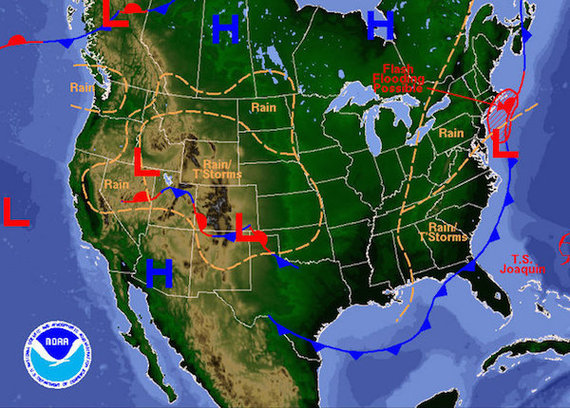You probably already know how to read temperature and precipitation forecasts. Those are the ones you check every morning to decide which jacket to grab as you're heading out the door.
But when you're heading out into the backcountry to brave the elements, it's important to pay more attention to the details of a weather report. When you're considering what to add to your backpacking checklist, you need to know a bit more than just temperature and rain forecasts.
1. Relative Humidity
Relative humidity is an important concept for understanding other weather-related measurements. The basic idea is simple -- air can hold a certain amount of water, based on its temperature. Warmer air can hold much more moisture than colder air can.
Relative humidity is a ratio of how much water is currently dissolved in the air, relative to how much water the air could potentially hold at its current temperature. When the relative humidity is around 80 percent, the air starts to feel "moist" and "sticky." When relative humidity is low, people say that the air feels "dry."
Relative humidity has a big impact how your body controls its moisture. You'll have problems drying out your gear or clothing in environments that have high humidity, and you may feel like you're constantly covered in sweat. Your hair may start to curl at humidity above 90 percent. Conversely, low humidities will make you more dehydrated, even thought you might feel less sweaty.
2. Dew Point
I already mentioned how warmer air can hold more moisture than colder air. So what happens if the relative humidity is very high, and then the temperature drops? The air can no longer hold all of that moisture, so it condenses into little droplets of dew or frost.
The temperature at which water will condense out of the air, for the given humidity, is called the dew point. If the temperature drops below this point, you can expect condensation to start forming everywhere.
Condensation happens first around colder surfaces like the ground or metal objects. You might also find condensation happening at temps above the dew point if you're in an especially humid area, like a poorly ventilated tent.
If you want to avoid waking up to a wet sleeping bag, make sure your shelter is well-ventilated to avoid excessive humidity building up. It also helps to be in an area that might hold heat better -- like under thick, low foliage -- so that the air stays warmer and doesn't drop below the dew point.
3. Atmospheric Pressure (aka "Barometric Pressure")
Atmospheric pressure is measured with a barometer, so it's sometimes referred to as "barometric pressure." It basically measures the "weight" of a column of air.
There are many different ways that atmospheric pressure is reported, but knowing the exact number and unit isn't too important. Instead, you should focus on the trend -- is the pressure generally going up or down?
If the air pressure is going up, you can expect the skies to clear up. Since the air is getting heavier and sinking down, it's warming which prevents clouds from forming.
If the air pressure is going down, you can expect clouds to start forming. Since the air is generally rising, it will start to cool and any moisture it's holding will condense into clouds, since it's crossing below the dew point. More information about air pressure here.
4. Cloud Cover
In addition to bringing precipitation, clouds have an important function in regulating the air temperature at the earth's surface.
When skies are clear, temperatures fluctuate a lot between the day and night. Sunlight will heat the earth's surface more effectively when there aren't clouds. But at night, all of that warm air will rise up into the sky and dissipate, making it much colder on the ground.
When skies are overcast, it tends to be cooler during the day without direct sunlight. But the clouds also functions as a thick blanket that holds the warm air down towards the earth, so it won't get as cold at night.
While it might be nice to lay out under the stars on a clear night, expect it to get much colder before the morning sun starts to rewarm things. Also, with that sharp drop in temperature overnight, you're more likely to dip below the dew point and wake up with a wet sleeping bag.
5. UV Index
The UV Index is a measure of the strength of the sun's ultraviolet rays, and higher values mean that your skin will start to burn faster.
mean that you should try to find shade around "solar noon," which is generally around noon or 1pm and tends to be the hottest part of day.
Anything higher than 6 means it's definitely time to put on sunscreen or protective clothing with a high UPF rating. You also probably want to be wearing sunglasses and a wide-brimmed hat to keep the sun off of your face and neck.
Make sure you check the UV Index anytime you're hiking anywhere else that doesn't have adequate tree cover or shade. It's easy to underestimate how badly you can get burned when you're hiking with no shade for hours a day.
6. Visibility
"Visibility" refers to the transparency of the air. It's not literally how far you can see, which depends on lighting, vantage points, obstructions, and many other factors.
In cities, visibility can be affected by smog and other air pollution. In the backcountry, visibility is more likely to be affected by fog, mist or haze.
Generally, a "clear" reading tops out at something around 10 miles. The number can be a bit misleading, since you can often see much farther from high vantage points on clear days. With a light haze, you might see a visibility rating around 2-3 miles, and with mist or fog, it'll usually be less than one mile.
It's important to know the visibility reading if you're planning on doing a trip that relies on big views or sight seeing.
If you'd like to learn more about the conditions for an upcoming backcountry trip, check out this simple tool that shows you detailed weather history for an area.
Our 2024 Coverage Needs You
It's Another Trump-Biden Showdown — And We Need Your Help
The Future Of Democracy Is At Stake
Our 2024 Coverage Needs You
Your Loyalty Means The World To Us
As Americans head to the polls in 2024, the very future of our country is at stake. At HuffPost, we believe that a free press is critical to creating well-informed voters. That's why our journalism is free for everyone, even though other newsrooms retreat behind expensive paywalls.
Our journalists will continue to cover the twists and turns during this historic presidential election. With your help, we'll bring you hard-hitting investigations, well-researched analysis and timely takes you can't find elsewhere. Reporting in this current political climate is a responsibility we do not take lightly, and we thank you for your support.
Contribute as little as $2 to keep our news free for all.
Can't afford to donate? Support HuffPost by creating a free account and log in while you read.
The 2024 election is heating up, and women's rights, health care, voting rights, and the very future of democracy are all at stake. Donald Trump will face Joe Biden in the most consequential vote of our time. And HuffPost will be there, covering every twist and turn. America's future hangs in the balance. Would you consider contributing to support our journalism and keep it free for all during this critical season?
HuffPost believes news should be accessible to everyone, regardless of their ability to pay for it. We rely on readers like you to help fund our work. Any contribution you can make — even as little as $2 — goes directly toward supporting the impactful journalism that we will continue to produce this year. Thank you for being part of our story.
Can't afford to donate? Support HuffPost by creating a free account and log in while you read.
It's official: Donald Trump will face Joe Biden this fall in the presidential election. As we face the most consequential presidential election of our time, HuffPost is committed to bringing you up-to-date, accurate news about the 2024 race. While other outlets have retreated behind paywalls, you can trust our news will stay free.
But we can't do it without your help. Reader funding is one of the key ways we support our newsroom. Would you consider making a donation to help fund our news during this critical time? Your contributions are vital to supporting a free press.
Contribute as little as $2 to keep our journalism free and accessible to all.
Can't afford to donate? Support HuffPost by creating a free account and log in while you read.
As Americans head to the polls in 2024, the very future of our country is at stake. At HuffPost, we believe that a free press is critical to creating well-informed voters. That's why our journalism is free for everyone, even though other newsrooms retreat behind expensive paywalls.
Our journalists will continue to cover the twists and turns during this historic presidential election. With your help, we'll bring you hard-hitting investigations, well-researched analysis and timely takes you can't find elsewhere. Reporting in this current political climate is a responsibility we do not take lightly, and we thank you for your support.
Contribute as little as $2 to keep our news free for all.
Can't afford to donate? Support HuffPost by creating a free account and log in while you read.
Dear HuffPost Reader
Thank you for your past contribution to HuffPost. We are sincerely grateful for readers like you who help us ensure that we can keep our journalism free for everyone.
The stakes are high this year, and our 2024 coverage could use continued support. Would you consider becoming a regular HuffPost contributor?
Dear HuffPost Reader
Thank you for your past contribution to HuffPost. We are sincerely grateful for readers like you who help us ensure that we can keep our journalism free for everyone.
The stakes are high this year, and our 2024 coverage could use continued support. If circumstances have changed since you last contributed, we hope you'll consider contributing to HuffPost once more.
Already contributed? Log in to hide these messages.

